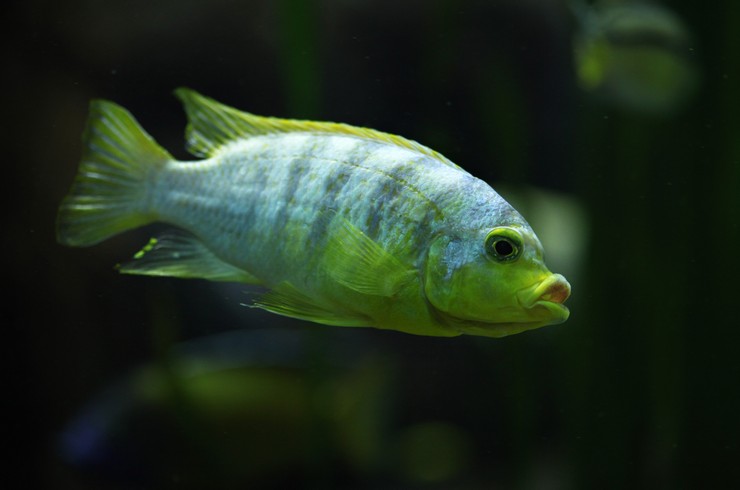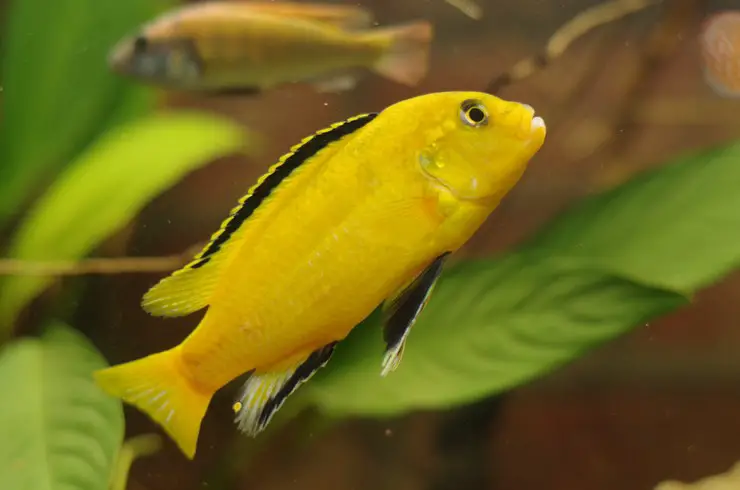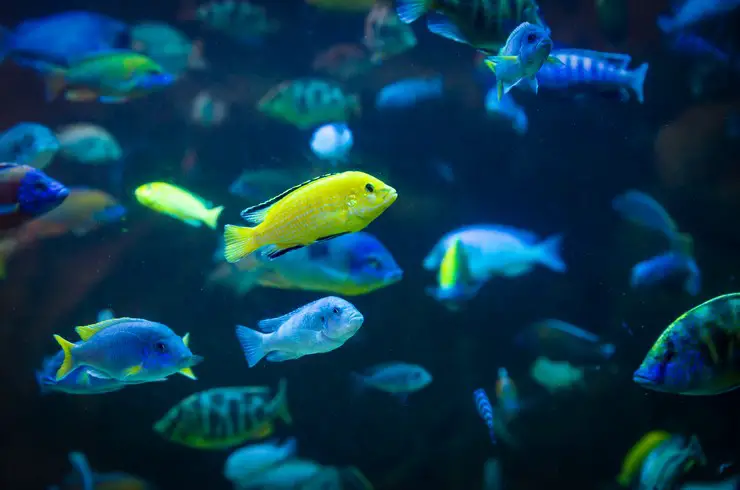Cichlids of Lake Malawi are popular aquarium inhabitants because they not only have amazing “outfits” but are also characterized by high intelligence and complex forms of behavior, which are a pleasure to watch. Labidochromis is the most peaceful group, it is with her that it is recommended to start your acquaintance with the wonderful world of the Malawians.
General information
Labidochromis (Labidochromis sp.) Is a genus of ray-finned fish from the Tsikhlov family. Currently, it includes 18 described species.
They are endemic to Lake Malawi in Africa and belong to the Mbuna group – these are cichlids that feed mainly on algal growths (and various invertebrates that live on them) on coastal rocks. The mouth apparatus of fish is ideally suited for scraping off lower plants: it is small in size with small elongated conical teeth, bent in the opposite direction, which is shaped like tweezers. Thanks to such teeth, labidochromis can extract algae even from the smallest depressions in the rocks. This is reflected in the name of the genus, derived from the Greek word “libidos” – tongs.
The fish are undemanding to conditions and are relatively peaceful, and are also easy to breed, therefore they are recommended to everyone who first decided to try their hand at keeping Malawian cichlids.
Appearance
The body shape of labidochromis is typical of most Malawian cichlids. It is streamlined, elongated, and slightly flattened laterally. The fish are quite stocky, the average size of an adult is 10 cm.
The dorsal fin is long and pointed, especially in mature males, and maybe edged with black stripes. The anal fin is oval, with bright orange spots.
The color of the body depends on the specific species and can be either monochromatic (Labidochromis yellow) or with stripes (Labidochromis hongi). Some species have geographic morphs that live in different areas of the lake and differ in color.
Habitat
Labidochromis are found only in the African lake Malawi (Nyasa). Most of all the fish gravitate towards the rocky shores near Tanzania, because there it is most convenient for them to find food for themselves – algal fouling. They keep at depths from 10 to 30 m.
Care and maintenance
They contain labidochromis in pairs or groups of a male and 3-4 females. The minimum aquarium volume is 100 liters. It should be covered with a lid to prevent pets from jumping out.
It is better to design an aquarium in a style reminiscent of the natural biotope of labidochromis. Sand or marble chips are placed on the bottom, which will alkalize the water. Next, you need to install a group of stones with an uneven surface, creating natural shelters, or artificial grottoes. But do not forget to leave free swimming space for the fish. It will be useful to plant Vallisneria in the aquarium, it will not only improve the quality of the water but also serve as an additional source of nutrition.
Labidochromis prefer clean, oxygenated water, so the installation of a suitable filter (preferably an external one) and a compressor is required. Also, the fish are thermophilic, because the water in the African lake of Malawi warms up quite well, so a thermostat will not be superfluous.
Once a week, it is necessary to replace 20% of the water in the aquarium with fresh water.
Compatibility
Labidochromis are cichlids with a very mild temperament. They rarely show aggression towards their aquarium neighbors, even during the spawning season. If you keep fish in groups, then they may not notice the existence of other inhabitants at all, and turn all their attention to their relatives. Only fish similar to them in color is not very fond of labidochromis, this point must be taken into account when selecting roommates.
Both commensurate cichlids (pseudotrophies, melanochromis, etc.), and some smaller species: iris, labeo, ancistrus, get along well with labidochromis. If the volume of the aquarium allows, then you can plant a synodontis or pterygoplicht with fish.
It is not recommended to keep labidochromis with very small and veiled fish species in order to avoid eating and biting off the fins.
Feeding labidochromis
The natural diet of labidochromis consists of algae, which scrape off rocks with their teeth. Various invertebrates living on algae are also eaten. Therefore, proper nutrition for labidochromis should include both plant food (mainly) and animal.
Feeding your fish only animal feed leads to digestive problems and serious illness. Therefore, it is better to abandon live and frozen food, which also poses a risk of contamination of the aquarium, and gives preference to high-quality dry food.
It is best to take a feed with a high content of spirulina algae as a basis – Tetra Cichlid Algae Mini or TetraPro Algae. They willfully provide the fish with the vegetation they need.
Most types of labidochromis are bright and colorful fish. To enhance the color of fish and make them even more attractive, use foods with natural carotenoids – Tetra Cichlid Color or Tetra Rubin.
Alternatively, Tetra Phyll or TetraMin is a versatile and complete feed for all tropical fish. They are made from over 40 selected plant and animal ingredients.
And, of course, don’t forget to pamper your pets with delicious natural treats from the Tetra FreshDelica series. Bloodworms or brine shrimp in nutritious jelly will perfectly diversify the diet of your fish.
It is recommended to feed Labidochromis 2-3 times a day, in small portions (which will be completely eaten within 2-3 minutes), and not to overeat.
Reproduction and breeding
Breeding labidochromis at home usually does not cause any difficulties. Fish reproduce well even in shared aquariums, often without outside interference.
Gender dimorphism is poorly expressed, therefore, it is probably possible to distinguish between a male and a female after the formation of a pair. Puberty in fish occurs at the age of 6-8 months. The stimulus for reproduction is an increase in temperature. The male prepares the place for spawning and lures the female there, which lays eggs. After fertilization, like many representatives of the Mbuna group, females of Labidochromis collect eggs into the oral cavity, where they develop. This process lasts about 3 weeks, during which the female does not feed at all. This evolutionary mechanism allows the fry to increase their chances of survival in nature.
Labidochromis are not highly fertile; there is rarely more than 25 fry in one brood. The eggs are relatively large – up to 3 mm in diameter. During the spawning and gestation period, it is advisable to maintain the temperature at 27 ° C. The fish hatched from the eggs are large enough to immediately accept dry food for the fry, for example, TetraMin Baby. It is important that there are plenty of hiding places in the aquarium for babies to hide in when they feel threatened by other fish.
